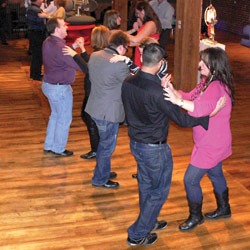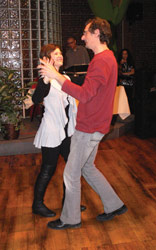A sensuous dance style continues to evolve.
A percussive, rhythmic dance known for its many turns and structured format, salsa can be traced back to African roots. As slaves were shipped to America, Cuba and the Greater Antilles during the trans-Atlantic slave trade, they brought their musical and dance traditions with them. According to Ed Caballero, a local DJ who teaches salsa dancing with his wife, Beverly, it was the Cubans who perfected salsa music, enhancing and expanding on these traditions.
From Cuba, salsa traveled to Puerto Rico, where more instruments were added and vocals were refined. There, the term salsa was first used to describe a genre of music and dance. The evolving tradition then moved to New Orleans, where it was characterized by a Latin jazz feel and fewer vocals. This new style, called mambo, saw its heyday in the 1950s and ‘60s. Its dance featured more forward and backward steps, whereas salsa was comprised of more side-to-side moves.
 It wasn’t until salsa traveled to cities like New York and Chicago that it really took off and became the salsa we know today. As the music progressed, dance followed suit, growing in popularity in the 1970s, ‘80s and ‘90s. After a brief hiatus, salsa is now making a comeback, and can be found around the globe, from Russia to China, Israel to Australia.
It wasn’t until salsa traveled to cities like New York and Chicago that it really took off and became the salsa we know today. As the music progressed, dance followed suit, growing in popularity in the 1970s, ‘80s and ‘90s. After a brief hiatus, salsa is now making a comeback, and can be found around the globe, from Russia to China, Israel to Australia.
People in different geographic locations dance their own styles of salsa. In larger American cities, Caballero said the favored dance is salsa On 2, in which the man begins by stepping backward with his left foot. Here in central Illinois, most dance salsa On 1, which begins with the man stepping forward with his left foot.
In Cuba, Casino Rueda, often shortened to Casino, is very popular. In this type of salsa, couples stand in a large circle while dance moves are announced by a caller. Dancers begin with the person they came with, but exchange partners throughout the dance. Growing in popularity, this type of salsa can now be found in Miami and elsewhere throughout the country, mainly on college campuses. But no matter where you are, or what type of salsa is preferred, one thing you can count on is dancing with a partner.
While the majority of salsa is danced to music with a quick tempo, boleros—slow, romantic dances—offer relief for the beginner or those who need a more moderate pace. “I’ll play some [slower] salsa after I teach a lesson to beginners,” said Caballero, “just so they can try to pick up the beat. Then, as I deejay the rest of the night, the music’s a little faster.” According to Caballero, the music being produced today is slower than the “hardcore” salsa music of the ‘70s, ‘80s and ‘90s.
 Raised in Harlem, Caballero grew up listening to R&B music. His older brother introduced him to salsa music when he was a teenager, and before long, he was accompanying his brother to nightclubs. “I really enjoyed the music,” he recalled, “but I didn’t know how to dance, which was a shame because that music…it makes you move, it makes you want to dance.” Once the contagion hit Caballero, he was hooked. He began to invest in LP records, and with his brother, amassed a collection of nearly 1,500 in no time.
Raised in Harlem, Caballero grew up listening to R&B music. His older brother introduced him to salsa music when he was a teenager, and before long, he was accompanying his brother to nightclubs. “I really enjoyed the music,” he recalled, “but I didn’t know how to dance, which was a shame because that music…it makes you move, it makes you want to dance.” Once the contagion hit Caballero, he was hooked. He began to invest in LP records, and with his brother, amassed a collection of nearly 1,500 in no time.
But it wasn’t until about eight years ago that Caballero took salsa lessons from a professor at Bradley University. Later, people would see him dance at the events he deejayed, and soon enough, they began asking if he would teach them salsa. With a passion for both the music and the dance, Caballero agreed, and with his wife, signed up to teach through the Peoria Park District. They have since begun teaching salsa lessons at Bradley and the Contemporary Art Center.
“I like to get people to dance with music that they’ve probably never heard before,” said Caballero. “It’s a good workout and it relieves stress. It takes away your problems for at least three or four minutes.” a&s
THE VARIED STYLES OF SALSA
As salsa made its way through the Americas, it left a trail of different styles in its wake. Here are a few of the distinguishing characteristics of the most popular styles.
Colombian Style. Also known as Cali style, this type of salsa is known for its diagonal movements in which dancers keep their upper bodies still while performing rapid and intricate footwork.
Miami Style. Unlike other styles that can begin on different beats, Miami salsa is exclusively danced On 1 and is marked by showy movements.
L.A. Style. Danced in a line, often called a slot, this style of salsa is known for its sensuousness, theatricality and musicality.
New York Style. Also danced in a line, New York salsa is begun on the second beat by the woman, or follower.


